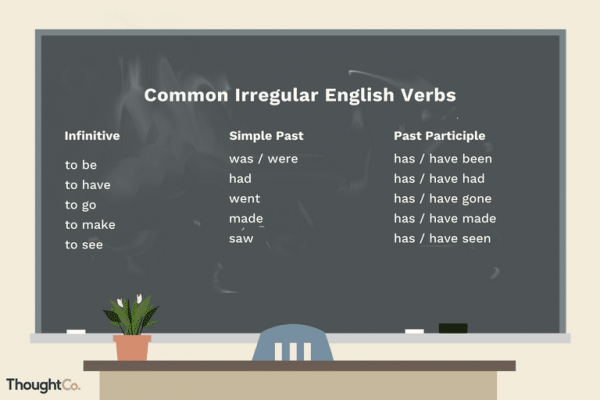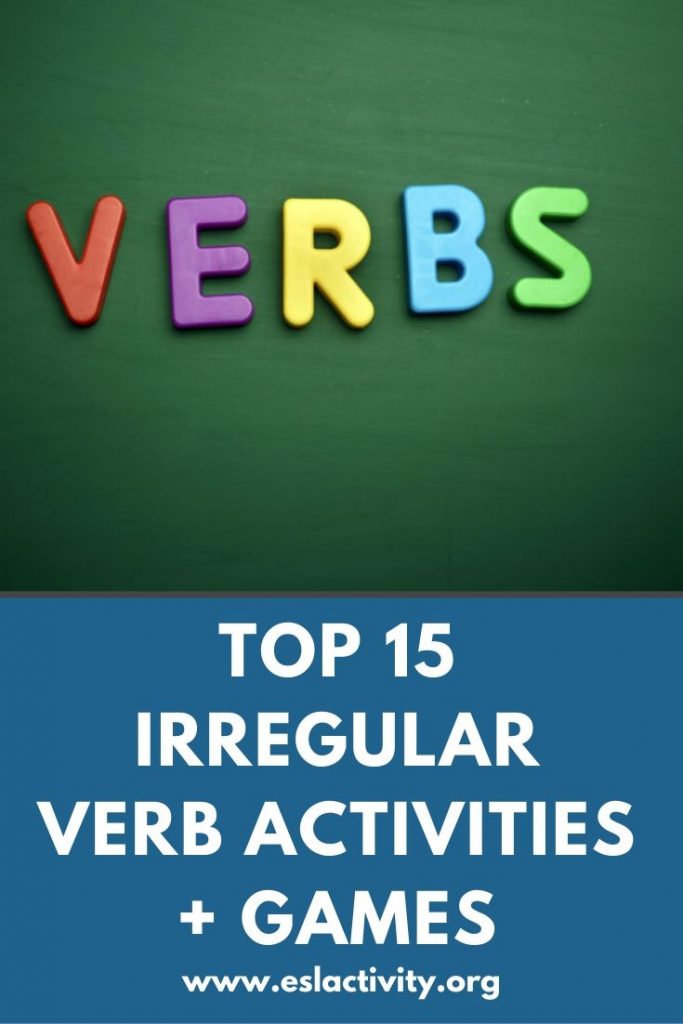Are you looking for some interesting, engaging irregular verb activities and games for your ESL/EFL classes? Then you’re most certainly in the right place. Keep on reading for all the irregular verb games you need, along with worksheets, lesson plans and lots of other good stuff!

Irregular verbs games and activities
Irregular Verb Activities and Games
Here’s what you’ve been waiting for! Keep on reading for the top irregular verb activities to try out in your English classes today.
#1: ESL Irregular Verb Surveys
One of my favourite activities that I like to do with my students is surveys. They’re interactive, cover a range of skills and best of all, get the students up and out of their seats to talk to their classmates. Perfect for those sleepy Monday mornings, right?
If you want to work on irregular past tense verbs, you could combine it with the present perfect if you require a follow-up question. For example:
Find someone who…
- …has been to another country?
- Where did you go?
- I went to Thailand.
See how that works? Just be sure to choose appropriate questions in order to facilitate irregular verb use. Do you want to try it out with your students? More details here about how to set it up:
#2: Concentration Memory Game
If you’re teaching beginners about irregular verbs for the first time, consider using this game at the end of class as a way to review key concepts. The way it works is that you can make sets of cards. One card will have the regular verb in the present tense while the other will have the irregular past tense verb. For example:
- eat/ate
- sleep/slept
- go/went
Then, prepare one set of cards for each group of 4 students. Then place them face down on the desk and try to find the matching set. From there, it basically becomes a memory game. Find out all the details you need to know right here;
ESL Concentration Memory Game.
- Amazon Kindle Edition
- Bolen, Jackie (Author)
- English (Publication Language)
- 87 Pages - 10/24/2019 (Publication Date)
#3: Proofreading and Editing
I like to use proofreading and editing as a quick warmer activity. If you’re focusing on ESL irregular verbs, a lot of the mistakes can be related to this. Students have to go through the passage and find all the errors. Here’s some more information about how to use this activity in your classes:
ESL Proofreading and Editing Warm-Up.
#4: Hot Potato Game
The hot potato game is a fun activity that most students really love. The way it works is that students pass around an object and then when the music or timer stops, the person holding the object has to do something.
In this case, you may want to say a verb and then students have to make a sentence using the irregular verb in the past. For example.
- Eat
- I ate pizza for dinner last night.
#5: Videos with Irregular English Verbs
There are a million and one ESL videos on YouTube and English Central. It’s a good time to be an English teacher, right? You can certainly find a ton of videos that feature irregular verbs. However, to get the best use of them, you’ll want to do some pre and post-watching activities.
Check out some of our top ideas right here: Using Videos for TEFL Teachers.
- Amazon Kindle Edition
- Bolen, Jackie (Author)
- English (Publication Language)
- 75 Pages - 05/31/2020 (Publication Date)
#6: Flashcard Sentences for Irregular English Verbs in the Past Tense
In my opinion, flashcards are one of those things that belong in the hand of every single ESL teacher for beginners in every single class! There are just so many activities that you can do with them.
In this case, you may want to put some flashcards on the table. Students have to pick 1-2 of them and then make a sentence in the past. If you choose the pictures carefully, they could lend themselves really well to irregular verbs. For example:
- I ate dinner with my Mom last night.
- I went to school
#7: Dictogloss
Try out this challenging listening activity that lends itself well to irregular English verbs. The way it works is that you find (or write) a passage with lots of irregular verbs in the past. It could be about a past vacation for example. Then, read it out at a slightly faster pace than the students are used to.
In pairs, students have to work to re-create the story either through speaking or writing. You can read the original more quickly and students can update theirs as needed. Finally, students can compare their version with the original. Hopefully they will have used the correct irregular verbs!
More details here: ESL Dictogloss Activity.
#8: Irregular Verbs Song
Songs, chants and raps are a fun way to learn English! Have a look on YouTube and you’re sure to find one that’ll work for your students.
#9: Irregular Verb ESL Speaking Lesson
It’s easier than you might think to plan your own lesson about almost anything, including irregular past tense verbs. Have a look at this video for the simple steps to follow:
#10: English Sentence Structure Activities
If you want to help your students work on irregular English verbs in the context of sentences, then you’ll want to check out these games and activities. They’re ideal for getting students to start using verbs in sentences and are also an excellent review for more advanced level students.
Do you want to see some ideas for this? Check this article out: ESL Sentence Structure Activities.
#11: Board Games for ESL Irregular Verbs
In real life, I’m ALL about playing board games which is why I like to use them with my students too. They’re fun and interactive. The best part is that you can use them for a variety of topics, grammatical points or vocabulary sets. If you design the questions well, it could be some teaching irregular verbs gold.
Do you want to find out more about how to make your own? Check this out:
Making your Own ESL Board Games.
#12: Is that Sentence Correct?
A quick warm-up activity for beginners is this activity. Write down a few sentences on the whiteboard or on the PowerPoint. Some have mistakes while others are fine. In this case, you’d want to focus on verbs, particularly the irregular ones.
Students have to decide if the sentence is correct or not and if it’s not, they have to change it. Do you want to learn more about this warmer or review activity? Check it out here:
Correct the Sentence ESL Warm-Up.
- Amazon Kindle Edition
- Bolen, Jackie (Author)
- English (Publication Language)
- 146 Pages - 06/18/2020 (Publication Date)
#13: Dialogue Substitution with Irregular Verbs
Maybe your students are kinda like mine? When they have a dialogue in the textbook (a common way to introduce irregular verbs), they mindlessly read it with their partner but have no idea what they read. It’s not their fault. It’s just that they didn’t have a reason to read! We can do better than this!
Something I like to do is take out all the verbs and students have to use the context of the sentence to figure out what goes in there. This takes it from an easy reading activity to one that challenges meaning as well. Try it out and I’m sure you’ll have some great results with it too.
#14: Whiteboard Games
Students love to write on the whiteboard! I think a lot of it has to do with the novelty factor. Whatever the reason, whiteboard games lend themselves really well to irregular verbs because you can do a lot of different races and relays. Here are some of the best ideas:
#15: Irregular Verb Memory Circle
A fun game to play with your students is this memory circle game. The way it works is that the first student says a statement using a target verb. Then, the next students repeat it and add their own. For example:
- I ate pizza for dinner last night.
- Tommy ate pizza for dinner and I went TV shopping last night.
The game continues on until one person is left standing. If you can’t remember a statement, you need to sit down. You can check out all the details right here: ESL Circle Game.
#16: Error Correction Relay Race
I love this relay race because it takes someone old (error correction) and makes it new again. It’s a fun change of pace for your students and a nice break from the same old routine.
In this case, you’d want to ensure that many of the mistakes are related to verbs, particularly the irregular ones. Find out how to play this game here: Error Correction Relay Race ESL.

ESL irregular verbs
#17: ESL Spelling Game
The spelling of irregular verbs in English can be a bit tricky for beginners. That’s why I like to focus on them in class with this fun spelling game. To mix things up a bit, consider saying either the irregular past tense verb or the present tense and students have to use their listening skills to decide which one it is.
You can see all the details here: ESL Spelling Activity.
#18: Running Dictation
#19: Teach Irregular Verbs with Eliciting
Unless your students are beginners, it’s likely they’ve already seen a number of irregular past tense verbs. If this is the case, using some eliciting techniques is an ideal way to start the class off with. There are two main reasons to consider doing so.
The first is that it’s easy to find out what the students already know about this grammatical point so you can tailor your lesson to what they don’t know. The second reason is that eliciting helps students activate any prior knowledge they may have about ESL irregular verbs. This makes new things easier to learn and remember.
There are a number of ways to do this. Here are some of the best ideas:
Using Eliciting in TEFL Classes.
#20: Dictation Irregular Past Tense Verb Activity
I know that dictation has kind of fallen out of favour these days with the more communicative approach to language teaching. However, it can be quite a useful exercise and certainly one to consider using for teaching irregular past tense verbs.
For beginners, say the irregular verb and students can write it in their notebooks. For higher-level students, you could say the base form of the verb and have students write down the past tense form. Or, you could say a sentence containing the target word.
Finally, you may want to dictate either a question or an answer. Then, have students write that down and either answer the question or form a question for the statement.
#21: Reading Lesson Plan with ESL Irregular Verbs
I like to mix things up a bit and do some dedicated reading lessons with my students. It’s an important skill that’s not often focused on in TEFL classes. It’s also possible to have a secondary focus to them besides reading, like reviewing irregular past tense verbs.
To learn how to design your own reading lesson based on whatever the target grammar or vocabulary is, have a look here:
ESL Reading Lesson Plan Template.
#22: Listening Lesson Plan
A nice way to introduce just about anything, including irregular English verbs is through a listening lesson. Find (or make your own) passage that contains lots of the target vocabulary. Then, follow these simple steps:
#23: Verb Charades
Write different irregular verbs on slips of paper and put them in a container. Students take turns choosing a slip and acting out the verb without speaking while the others try to guess the verb.
#24: Verb Auction
Give students a list of irregular verbs and assign them a certain amount of fake money. They will bid on verbs, trying to collect as many pairs of base form and past tense or past participle as possible. The student with the most pairs at the end wins.
#25: Verb Storytelling
Ask students to create a story using as many irregular verbs as they can. Encourage them to be creative and use the verbs correctly in the past tense or past participle form. They can present their stories to the class.
#26: Verb Race
Divide the class into teams. Write the base form of irregular verbs on the board, and students from each team take turns running to the board and writing the past tense or past participle form of the verb. The team with the most correct answers in a given time wins.
#27: English Verbs Quiz
Irregular Verbs Worksheets
Do you want some irregular verb worksheets that you can print and go? I’m sure you do! It’s an easy way to get your students practicing this important skill without a ton of work on your part. Here are some of our favourite resources:
Irregular Verbs Lesson Plans
If you want some ESL lesson plans that focus on irregular English verbs, then you’ll want to check out our top recommendations right here:
Did you like these Irregular Verbs Games and Activities?
- Amazon Kindle Edition
- Smith, Jennifer Booker (Author)
- English (Publication Language)
- 144 Pages - 03/31/2016 (Publication Date)
Yes? Thought so. Then you’re going to love this book over on Amazon: 101 ESL Activities for Kids. The key to better English classes with children is a wide variety of engaging, interesting and student-centred activities. This book will help you do that in style.
The best part is that the book is organized into various sections so you should be able to find an activity or game that’ll work with your students in just a minute or two. If that’s not some ESL teaching gold, then I’m not really sure what it is!
The book is available in both digital and print formats. Take the electronic version with you on your phone or tablet for some serious lesson planning at your favourite coffee shop. Or, keep the physical book on the bookshelf in your office to use as a handy reference guide. It really is that easy to have better English classes.
Does it sound like exactly what you need? Head on over to Amazon to learn more about the book right here:
FAQs about Irregular English Verbs
There are a number of common questions that people have about this topic. Here are the answers to some of the most popular ones.
Why do English learners need to learn irregular verbs?
English learners need to learn irregular verbs because they are commonly used in the English language, and not knowing them can lead to confusion and errors in communication.
How many irregular verbs are there in English?
There are over 200 irregular verbs in English.
How can I teach irregular verbs to English learners?
You can teach irregular verbs by using various techniques such as flashcards, games, sentence completion exercises, and regular practice.
Can you give some examples of irregular verbs?
Yes, here are a few examples: “go” (went), “eat” (ate), “see” (saw), “buy” (bought), “take” (took).
Are irregular verbs used only in the past tense?
No, irregular verbs are used in both the past tense and the past participle form. For example, “eat” (ate/eaten) and “drink” (drank/drunk).
How can English learners remember irregular verbs?
English learners can use mnemonic devices, create lists, practice with exercises, and engage in regular conversation and writing to help remember irregular verbs.
Are irregular verbs the same in all forms?
No, irregular verbs have different forms for the base form, past tense, and past participle. Each form can be different and must be learned individually.
Can irregular verbs change in the present tense?
No, irregular verbs do not change in the present tense. They only have irregular forms in the past tense and past participle.
Are there any patterns in irregular verbs?
While irregular verbs do not follow a specific pattern like regular verbs, some irregular verbs may share similarities in their forms. However, it is best to learn them individually as they can vary widely.
Tips for Teaching Irregular English Verbs
Teaching irregular verbs in ESL can be challenging due to their unique forms and unpredictable patterns. However, with the right strategies and approaches, you can make the learning process more engaging and effective. Here are some tips for teaching irregular verbs:
Introduce Irregular Verbs in Context
Present irregular verbs in meaningful contexts, such as short stories, dialogues, or real-life situations. This helps students understand how irregular verbs are used naturally in everyday language.
Categorize Irregular Verbs
Group irregular verbs into categories based on their patterns. Common categories include verbs that change their base form (e.g., sing – sang – sung), verbs that change their vowel sound (e.g., take – took – taken), or verbs with completely irregular forms (e.g., go – went – gone).
Use Visual Aids and Realia
Incorporate visual aids, such as flashcards or images, to represent irregular verbs. Include pictures that illustrate the verb’s action or meaning to aid in comprehension. Realia, such as objects or props related to the verbs, can also make the learning experience more memorable.
Provide Clear Explanations and Examples
Clearly explain the irregular verb forms, emphasizing the changes in spelling or pronunciation. Give examples of sentences using the different forms of the irregular verb to reinforce understanding. Highlight the irregularity and draw comparisons with regular verb forms.
Engage in Repetition and Practice
Repetition is key when teaching irregular verbs. Provide ample opportunities for students to practice using irregular verbs in various contexts, such as through oral drills, written exercises, or interactive games. Reinforce correct usage and provide corrective feedback when needed.
Use Mnemonic Devices
Mnemonic devices can help students remember irregular verb forms. For example, creating catchy phrases or rhymes for irregular verb pairs like “sing, sang, sung” or “take, took, taken” can make the forms more memorable.
Incorporate Multi-Sensory Activities
Engage multiple senses during the learning process. For example, have students write irregular verb forms on flashcards and physically sort them into the correct categories. They can also practice pronunciation by listening to recordings or songs that feature irregular verbs.
Review and Recycling
Regularly review previously taught irregular verbs to reinforce students’ memory and understanding. Incorporate regular recycling activities, such as quick quizzes, games, or sentence completion exercises, to reinforce the learning of irregular verb forms.
Provide Authentic Language Input
Expose students to authentic language materials, such as songs, videos, or texts, that feature irregular verbs. This helps students encounter irregular verbs in natural contexts and reinforces their usage.
Encourage Communication
Create opportunities for students to use irregular verbs in meaningful communication. Role-plays, discussions, or writing activities that require the use of irregular verbs can help students practice using them in a more authentic and purposeful way.
ESL Irregular Verb Games: Join the Conversation
What do you think about these irregular past tense verbs games and activities? Did you try out one of them from this list or do you have another recommendation? Leave a comment below and let us know. We’d love to hear from you. Also, if you are interested in more grammar resources, check out our article on punctuation marks.
Also be sure to give this article a share on Facebook, Pinterest, or Twitter. It’ll help other busy teachers, like yourself find this useful resource.
Last update on 2022-07-17 / Affiliate links / Images from Amazon Product Advertising API








